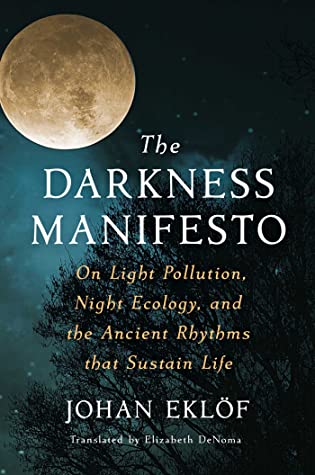The Darkness Manifesto caught by eye in the netgalley listings, as it was an examination of darkness and its scarcity. It seemed to fit well with the other non-fiction books I’ve taken this year. It takes me to just one away from my stretch target of the Non-Fiction Adventure reading challenge this year. And I know what the last one will be!

The Darkness Manifesto
On Light Pollution, Night Ecology, and the Ancient Rhythms that Sustain Life
By Johan Eklöf, Elizabeth DeNoma (Translation)
How much light is too much light? Satellite pictures show our planet as a brightly glowing orb, and in our era of constant illumination, light pollution has become a major issue. The world’s flora and fauna have evolved to operate in the natural cycle of day and night. But in the last 150 years, we have extended our day—and in doing so have forced out the inhabitants of the night and disrupted the circadian rhythms necessary to sustain all living things, including ourselves.
In this persuasive, well-researched book, Swedish conservationist Johan Eklöf urges us to appreciate natural darkness, its creatures, and its unique benefits. Eklöf ponders the beauties of the night sky, traces the errant paths of light-drunk moths and the swift dives of keen-eyed owls, and shows us the bioluminescent creatures of the deepest oceans. As a devoted friend of the night, he writes passionately about the startling damage we inflict on ourselves and our fellow creatures simply by keeping the lights on. […]
Educational, eye-opening, and ultimately encouraging, The Darkness Manifesto outlines simple steps that we can take to benefit ourselves and the planet. In order to ensure a bright future, we must embrace the darkness. (goodreads)
My Review
This is an excellent book, full of interesting evidence, arguments, and food for thought. The writer has an engaging style, although he does tend to jump about from one subject to another. It may be Kindle run-on formatting to a certain extent. Eklöf covers a huge amount of material, all of it of interest to me, from bats his specialism) to LEDs. He covers evolution of sight: I’ve not considered how we got from primordial soup to animals with eyes and other sensory organs developed. There is plenty of delving into geological evidence, often in Sweden, in different types of geology from that I’m used to.
In many ways this was the charm of the book. It is cross-cutting in terms of its scientific disciplines, but in a way that delves further than my scope. The examination of the physics of light blends into the structure of the eye. Yes, we did this school. But what about the development of sight in other ways, and the adaptations of human eyesight to low levels?
We are still speculating about the exact form of sight in other mammals. All we can guess is that their ability to see infrared somehow ‘looks’ like our IR cameras. But we only know they see things differently at night. It made me think more about my own pets, not only what they see, but the light conditions that they need for health. In the Darkness Manifesto, the author devotes a large section to the physical need for changing light. Not just light intensity but hue, for a period of natural darkness. This leads into how light pollution disrupts whole ecologies. The food chain will collapse if we don’t act fast.
lost in translation?
Whether it was the translation or something else, there were several phrases that didn’t make sense to me. Some were funny, others just left me wondering what the author meant. ‘Undecayed animals’ in a rock formation confused me. The statue of a scientist where ‘you’ll see a small box with a bat on one knee’ amused me. Is the bat kneeling on the box? Has the box got a knee? Just one thing that could be phrased better.
‘Research shows that badly directed and unnecessarily strong lights in Europe and the US are equivalent to the carbon dioxide emissions of nearly 20 million cars.’ I’d like the citation, please….
I made simply plenty of notes because I would like to follow them up. This book did not have references in the text, and I really wanted them. I would love to send the relevant research links to our highways department, who recently consulted us on street lighting plans. There is a Reference section at the back, in alphabetical order, but no hint in the text to help you find the one you want. Paper titles are not necessarily obvious. The references and further reading take 10% of the book. A nice chunk.
Usability details aside, this is an important book. It covers the many aspects of light pollution in a pragmatic way, as well as re-examining the human relationship with the dark. And finishes with great examples of countries that are making a difference.
Book Review | The Darkness Manifesto by Johan Eklöf. An important and enjoyable investigation of our relationship with darkness and why we need more of it #health #lightpollution #climatechange #TheDarknessManifesto #netgalley Click To Tweet

We are not looking to after our planet are we? 💜
I’ve known about this for a long time – so this book might explain the consequences.
Pingback:Light in Darkness #IWSG #Giftmas2022 - Jemima Pett
Pingback:Book of the Year 2022 - Jemima Pett